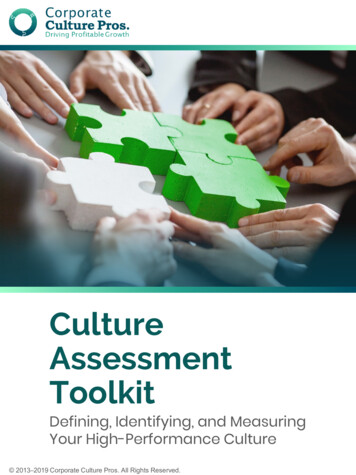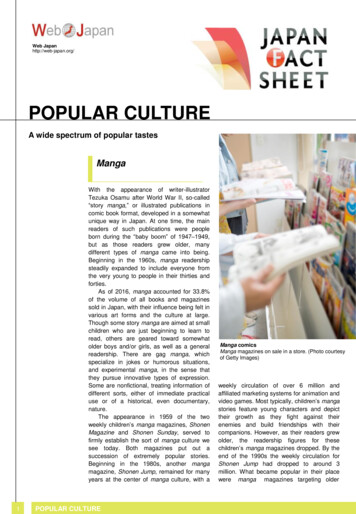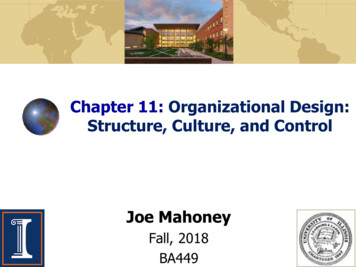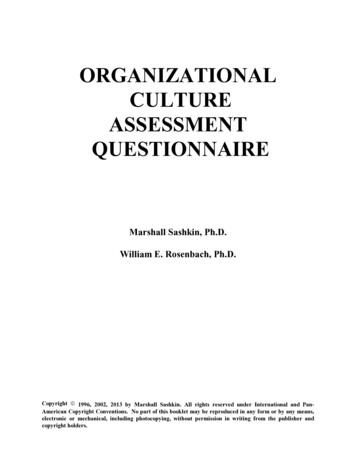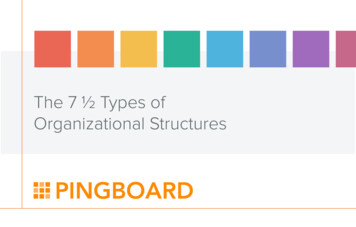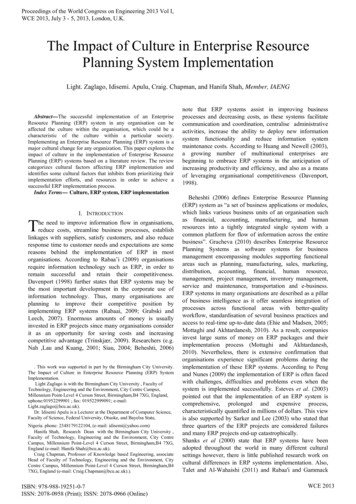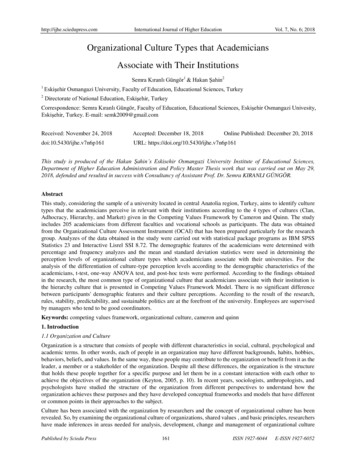
Transcription
http://ijhe.sciedupress.comInternational Journal of Higher EducationVol. 7, No. 6; 2018Organizational Culture Types that AcademiciansAssociate with Their InstitutionsSemra Kıranlı Güngör1 & Hakan Şahin21Eskişehir Osmangazi University, Faculty of Education, Educational Sciences, Turkey2Directorate of National Education, Eskişehir, TurkeyCorrespondence: Semra Kıranlı Güngör, Faculty of Education, Educational Sciences, Eskişehir Osmangazi Univesity,Eskişehir, Turkey. E-mail: semk2009@gmail.comReceived: November 24, 2018Accepted: December 18, 2018Online Published: December 20, 2018doi:10.5430/ijhe.v7n6p161URL: https://doi.org/10.5430/ijhe.v7n6p161This study is produced of the Hakan Şahin’s Eskisehir Osmangazi University Institute of Educational Sciences,Department of Higher Education Administration and Policy Master Thesis work that was carried out on May 29,2018, defended and resulted in success with Consultancy of Assistant Prof. Dr. Semra KIRANLI GÜNGÖR.AbstractThis study, considering the sample of a university located in central Anatolia region, Turkey, aims to identify culturetypes that the academicians perceive in relevant with their institutions according to the 4 types of cultures (Clan,Adhocracy, Hierarchy, and Market) given in the Competing Values Framework by Cameron and Quinn. The studyincludes 205 academicians from different faculties and vocational schools as participants. The data was obtainedfrom the Organizational Culture Assessment Instrument (OCAI) that has been prepared particularly for the researchgroup. Analyzes of the data obtained in the study were carried out with statistical package programs as IBM SPSSStatistics 23 and Interactive Lisrel SSI 8.72. The demographic features of the academicians were determined withpercentage and frequency analyzes and the mean and standard deviation statistics were used in determining theperception levels of organizational culture types which academicians associate with their universities. For theanalysis of the differentiation of culture-type perception levels according to the demographic characteristics of theacademicians, t-test, one-way ANOVA test, and post-hoc tests were performed. According to the findings obtainedin the research, the most common type of organizational culture that academicians associate with their institution isthe hierarchy culture that is presented in Competing Values Framework Model. There is no significant differencebetween participants' demographic features and their culture perceptions. According to the result of the research,rules, stability, predictability, and sustainable politics are at the forefront of the university. Employees are supervisedby managers who tend to be good coordinators.Keywords: competing values framework, organizational culture, cameron and quinn1. Introduction1.1 Organization and CultureOrganization is a structure that consists of people with different characteristics in social, cultural, psychological andacademic terms. In other words, each of people in an organization may have different backgrounds, habits, hobbies,behaviors, beliefs, and values. In the same way, these people may contribute to the organization or benefit from it as theleader, a member or a stakeholder of the organization. Despite all these differences, the organization is the structurethat holds these people together for a specific purpose and let them be in a constant interaction with each other toachieve the objectives of the organization (Keyton, 2005, p. 10). In recent years, sociologists, anthropologists, andpsychologists have studied the structure of the organization from different perspectives to understand how theorganization achieves these purposes and they have developed conceptual frameworks and models that have differentor common points in their approaches to the subject.Culture has been associated with the organization by researchers and the concept of organizational culture has beenrevealed. So, by examining the organizational culture of organizations, shared values , and basic principles, researchershave made inferences in areas needed for analysis, development, change and management of organizational culturePublished by Sciedu Press161ISSN 1927-6044E-ISSN 1927-6052
http://ijhe.sciedupress.comInternational Journal of Higher EducationVol. 7, No. 6; 2018(Şişman, 2015, p.163). According to the aim of the researches, the organizational culture has been studied in order toprovide different benefits in areas of the organization, such as the determination of the necessary changes for theefficiency of the organization, determining the changes necessary for the efficiency of the organization and theorganization in the environment where the organization is located (Bolman ve Deal, 2017, p. 10).1.2 Organizational CultureOrganizational culture has been used as a term in the systematic analysis of organizational culture in the late 1970s andearly 1980s. Especially in the 1980s and 1990s, the organizational culture was perceived by many researchers as theonly key to organizational success (Alvesson ve Sveningsson, 2016, p. 40). It is difficult and complex to define theconcept of organizational culture. The reason for this difficulty arises from the use of culture as a term in a wide andvaried sense, as well as the fact that culture has a structure so deep that it cannot be easily observed (Schabracq, 2007,p. 7). As a matter of fact, in defining the culture, it is necessary to go below the behavioral dimension, because it maycause other factors other than culture (Schein, 2010, p. 22). In addition, if the methods used by researchers tounderstand the meaning of the term are not fully understood, the definitions they make do not have much meaning,because how the culture is understood has equal importance with how it is studied (Ehrhart, vd., 2014, p. 125).Although the researchers dealt with the concept from different perspectives and dimensions, it is seen that thedefinitions and explanations they made about the concept meet in the common pot at the point of shared values andbeliefs. For example, Itzin and Newman (2005, p. 10) discusses organizational culture in terms of gender relations anddiscusses organizational culture in terms of shared symbols, language, the way things are done and deeply establishedbeliefs and values in their books 'Gender, Culture, and Organizational Change'. They consider these cultural elementsas an environment in which sexual identity, sexist practices, and inter-gender power relations are maintained.According to Kwantes and Glazer (2017, p. 10), the elements and levels of the concept of culture were examined in asimple manner, but culture resulted in only a partial definition. Culture is included in a social context with internalizedvalues, beliefs and practices as an individual phenomenon. In this way, the culture defined at the individual level showsa common context with the culture at the group level.Likewise, Deshpande and Webster (1989, p. 4), who connect different definitions of the concept of organizationalculture to different theoretical backgrounds created for the concept, explain organizational culture as a model ofcommon beliefs and values that enable individuals to understand the functioning of the organization and presentexamples of behavior in the organization. Schein (2010, pp. 18-29), who is one of the leading figures in the field oforganizational culture, considers organizational culture in terms of leadership in his book ‘Organizational Culture andLeadership’ and sees the leader as the initiator of the emergence of culture and describes the culture and leadership astwo faces of the same coin. In the same book, organizational culture is defined as a common basic assumptions modelthat a group acquires in solving internal integration and external adjustment problems.Kates and Galbraith (2007, p. 3), one of the other researchers who emphasize leadership, state that organizationalculture is shared by many members and formed by common behavior norms, disposition, and values. Organizationalculture is the result of organizational decisions taken in the past and the accumulation of leadership and leadershipbehaviors that have emerged as a result of these decisions. Ashkanasy (2000, p. 21) examined the concept oforganizational climate in his book ‘Organizational Culture and Climate' and associated the concept with theorganizational culture. For him, it is the organizational climate that constitutes the organizational culture or vice versa.Organizational climate is a visible layer of organizational culture. Ashkanasy discussed organizational culture fromthree different perspectives. In terms of structural reality, the organization has qualities such as climate and culture.When evaluated in terms of social structure, the distinguishable order in organization activities constitutesorganizational culture. The third aspect deals with the organization and culture in terms of linguistic conformity andstates that these concepts serve for the sake of encouraging us to consider.On the other hand, it is important to understand what the organizational culture does not represent, in other words, whatit is not. According to Gallagher (2003, p. 4), organizational culture is not about the products or services offered by theorganization, but about the value judgments and beliefs of the organization. Organizational culture is not externallypromoted or established, but occurs spontaneously within the organization without being explicitly stated, instead.Organizational culture is not about the policies and procedures of the organization but about the style of theorganization. Organizational culture is not related to the recruitment process of the organization but related to thehuman model that is taken into consideration when getting members. Organizational culture is not about expressingbehaviors desired to be exhibited, but about rewarding desired behavior.Published by Sciedu Press162ISSN 1927-6044E-ISSN 1927-6052
http://ijhe.sciedupress.comInternational Journal of Higher EducationVol. 7, No. 6; 20181.3 Organizational Culture in UniversitiesUniversities are one of the few institutions that have almost never changed from the Middle Ages to the present interms of their structure and functioning. The main purpose of higher education institutions is the creation anddissemination of knowledge. While the organizational focus is science, organizational units are departments in theuniversity. The source of the identity perception they have for the academic staff is the scientific and professionalcommunities they belong to with the science they are interested in rather than their corporate membership in theinstitution they work for (Sanyal, 1996, p. 4). In the 21st century, universities have a structure that serves wider,more complex, diverse students and chase wider targets than in the past (Scott, 2013, p. 15). The universities, whichhave a continuous and rapid change in social, technological, economic and political aspects, are obliged to adapt tothese changes. In the pressure environment caused by this rapid change at both global and international levels,universities accelerate academic reforms such as the creation of common markets, the mobility of students and staff,free movement of services and products (Beytekin, Yalçınkaya, Doğan ve Karakoç, 2010, p. 2).Each university has its own culture. Everything from the university's name, logo, colors, mission, and history to theuniversity's campus, architecture, the method of business management, graduates, community and clubs is a part ofthis culture. Each university has both an institutional culture with its goals, beliefs, and traditions evolved from itshistory, as well as subcultures shared between administrators, faculties, faculty, and students. Universities aregoverned by a structure consisting of faculty boards, faculty members and administrative managers rather than byone-handed CEOs, as in the business World (Min, 2017, pp. 27-32).The organizational culture of the university is a special phenomenon due to the fact that the education departmentsrely on a self-organized system based on the principles of knowledge and learning. University culture; within thescope of internal relations, functions as a platform in which academic and administrative managers, academic andadministrative staff and students, public and private sector executives, alumni and parents of them, employers andpartners from other educational institutions, competitors, and non-governmental organizations build variousrelationships (Vasyakin, Ivleva, Pozharskaya and Shcherbakova, 2016, p. 2). As can be seen, the university seesitself as an organizational actor, which constitutes a subjective strategy in the socioeconomic strife of contemporarysociety, that is, it has an important role in the formation of the information infrastructure and broadens the area ofcommon values and beliefs (Serdenciuc, 2015, p. 5).1.4 The Importance of Detecting Culture in UniversitiesAll these structural features and functions of the universities have an effective role in their culture. Therefore, studyingthe cultural features of the universities will provide convenience to academicians, administrative staff, managers instrategy development, and decision-making processes for all stakeholders of the university. In this study,organizational culture is handled in terms of universities with higher education institutions. In this research carried outthrough the university, the type of organizational culture that academic staff perceived regarding their institutions wasanalyzed by using Competitive Values Framework model developed by Cameron and Quinn (2006).1.5 Objectives of the StudyThe aim of this research is to reveal the levels of organizational culture types perceived by the academic staff workingin the university by using the Competing Values Framework Model developed by Cameron and Quinn. The main aimof this study is to find out which c
from the Organizational Culture Assessment Instrument (OCAI) that has been prepared particularly for the research group. Analyzes of the data obtained in the study were carried out with statistical package programs as IBM SPSS Statistics 23 and Interactive Lisrel SSI 8.72. The demographic features of the academicians were determined with percentage and frequency analyzes and the mean and .
